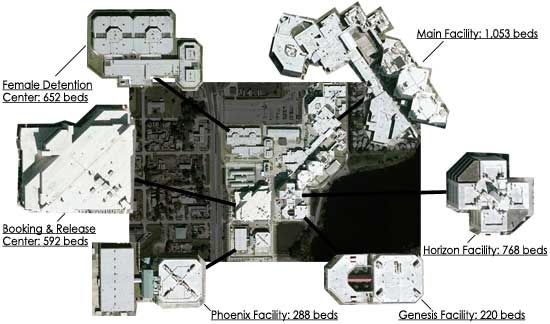By Luke Whyte
Corrections1 recently sat down with Chief Michael Tidwell of the Orange County Corrections Department (OCCD) to discuss some of the department’s latest initiatives. The following is the first in our new “Featured Facility” series, in which we examine forward-thinking correctional institutions from across the United States, and share their good ideas and achievements with our readership.
The hope is that by collecting great ideas in correctional management from around the country, we can build a database of information that will be of great use to correctional professionals everywhere. We want to hear your innovative ideas and initiatives, so send us an email with a synopsis of your story. Perhaps yours will be the next “Featured Facility” on Corrections1.
The Map
This map shows all of OCCD’s facilities. Click the image to see a more detailed version.
 |
Raw Numbers
In total, OCCD detains close to 4,000 inmates with around 1,850 officers in seven facilities. Four of those facilities are direct supervision, one is booking and release, another is a work release center and the last one — the main jail — is a 1,053 bed traditional “linear” style facility.
“I can attest that it is easier to manage direct supervision facilities,” Chief Tidwell says. “They are easier and more fluid to operate and I think the inmates appreciate it more, too.”
Combating Prison Gangs
OCCD realized a couple years ago that, despite their internationally-recognized gang unit, they still didn’t have a good understanding of what (and who) their prison gangs were really affecting.
“Our gang unit would be told of a gang issue in one unit,” Tidwell said. “They would identify the persons involved, remove them and then issue a report. That would be that.”
So they decided to switch to a more “ground up” approach to identifying and dealing with gangs.
“We readjusted the program and developed a Security Intel Unit,” Tidwell said. “This unit is made of veteran COs who question inmates (gang-involved or not), gather intelligence and then vet it.”
This new approach has enabled OCCD to uncover a far better understanding of the how the gang dynamic functions in their agency.
Now when OCCD hears of gang activity in one unit, they still investigate and identify the persons involved. However, rather than reacting quickly to smother the individuals, they gather intelligence on “their tentacles across other units,” Tidwell said. “We then focus on connectivity.”
“If you are solely looking at individual gangs and members,” Tidwell says, “you are missing stuff that is key. Get any information you can; relevant or not.”
“We’ve gone from a focused approach to a large problem to a large approach to small incidents.”
Attorney Laptops
Like most correctional institutions, OCCD is tasked with maintaining security amid a daily stream of arriving attorneys.
“Most attorneys nowadays use computers,” Chief Tidwell said. “And they were bringing laptops into our facilities.”
OCCD came up with an interesting approach to combating this issue. They purchased a series of small notebook computers and had them stripped of all programs except a word processor.
Now when attorneys arrive at an OCCD facility, they’re only allowed to bring a portable flash drive inside with them. Once in the facility, the attorney is given an OCCD laptop which they can plug the flash drive into. They then return the laptop when they leave. By limiting attorney access to just word processing programs, OCCD has been able to dramatically curb this security concern.
“I can’t tell you how many attorneys visit us each day,” Tidwell said. “But we’ve found that this approach works well with us.”
Going Paperless
“Every jail is only as good as the paperwork it survives on,” Chief Tidwell said. Nonetheless, paperwork ends up costing all agencies a whole lot of money. Thus, OCCD made the decision to go completely paperless.
The department is in the process of moving all of its hard copy files into digital copies for storage on their computer system.
“It will save us hundreds of thousands of dollars, “Tidwell said, “and will allow us to keep our records in a whole new style.”
Building Culture Strategically
“Building Culture Strategically” is a concept developed by the National Institute of Corrections at the U.S. Department of Justice. The idea is to develop “a team approach for corrections” that will help all staff to work more fluidly and enthusiastically.
Eighteen months ago, OCCD, like many agencies across the country, was finding that many of its departments weren’t working together to their full potential. Some staff members were hostile towards each other and better communication was needed. So they decided to rebuild their team approach.
Chief Tidwell said that the Building Culture Strategically concept teaches agencies to “value the best resource they have: It’s own people and the people they serve.” By working with staff to develop a series of department goals, OCCD are seeking to make their agency a better place for its staff. In turn, they’re improving morale and increasing work ethic.
“The process is based on initial surveys,” Tidwell said. “We conducted surveys centering around the employee work atmosphere and the jobs individuals do. We had seven teams looking at operations and attitudes. We then drew conclusions from which we developed our own action plan.”
OCCD was fortunate enough to have Carol Flaherty — one of the programs original developers — come on as a facilitator to the process.
“What we found,” Tidwell said, “is that we do some technical things very well, but from the human interest part, we learned we weren’t friendly in all those goals.”
As a team, OCCD developed a series of goals that “will make this a better place for our staff.”
“I think it is going to fundamentally change the way we do business,” Tidwell said.
Many agencies nationwide could benefit from this initiative. To learn more about how your department or facility could us “Building Culture Strategically” check out the NIC’s comprehensive report on the subject here: http://nicic.org/Downloads/PDF/Library/021749.pdf











